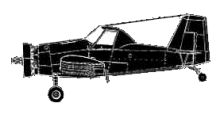
ASN Wikibase Occurrence # 290553
This information is added by users of ASN. Neither ASN nor the Flight Safety Foundation are responsible for the completeness or correctness of this information.
If you feel this information is incomplete or incorrect, you can submit corrected information.
| Date: | Thursday 12 June 2014 |
| Time: | 12:00 LT |
| Type: |  Air Tractor AT 301 |
| Owner/operator: | Smith Company Flying Service |
| Registration: | N8593S |
| MSN: | 301-0157 |
| Year of manufacture: | 1978 |
| Total airframe hrs: | 8357 hours |
| Engine model: | P&W R 1340-AN-1 |
| Fatalities: | Fatalities: 0 / Occupants: 1 |
| Aircraft damage: | Substantial |
| Category: | Accident |
| Location: | Pearsall, Texas -
 United States of America United States of America
|
| Phase: | Manoeuvring (airshow, firefighting, ag.ops.) |
| Nature: | Agricultural |
| Departure airport: | Pearsall, TX (T30) |
| Pearsall, TX (T30) | |
| Investigating agency: | NTSB |
| Confidence Rating: |
The pilot reported that, while returning to the airport after spraying a cornfield, he noticed that the engine cylinder head temperature was high. After landing, he checked the engine cylinders for discrepancies and found none, so he decided to continue the spraying operations at the cornfield. As the pilot pulled up the airplane from a spray run, the engine started to vibrate and lose power. He subsequently made a forced landing in a nearby field, which resulted in the airplane sustaining substantial damage to both wings.
During postaccident examination, a considerable amount of metal was found in the oil drain. The No. 2 cylinder front spark plug was loose. After removing all of the spark plugs, an attempt was made to rotate the engine, but it seized. After removing the No. 1 cylinder, it was discovered that the piston rod had broken at the link pin; no other rods were broken. The No. 1 cylinder link pin was scored, and there was evidence of oil starvation at the rod bearing. According to the operator, the engine had accrued about 100 hours since it had received extensive maintenance, including the replacement of the crankshaft. It is likely that the oil cooler was not properly flushed when the crankshaft was replaced and that metal and other debris remained in the oil, clogged the drain, and caused the piston to fail.
Probable Cause: The failure of the No. 1 cylinder rod at the link pin. Contributing to the accident was oil starvation to the rod bearing due to the improper flushing of the oil cooler, which allowed metal and other debris in the oil to clog the drain and the led to the piston's failure.
Accident investigation:
 |
|
Sources:
NTSB CEN14LA287
History of this aircraft
Other occurrences involving this aircraft
| 12 June 2013 | N8593S | Private | 0 | Field near Pearsall, Texas |  |
sub |
Location
Revision history:
| Date/time | Contributor | Updates |
|---|---|---|
| 06-Oct-2022 16:30 | ASN Update Bot | Added |
Corrections or additions? ... Edit this accident description
The Aviation Safety Network is an exclusive service provided by:


 ©2024 Flight Safety Foundation
©2024 Flight Safety Foundation